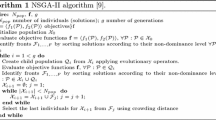Abstract
In this paper, we propose a genetic programming (GP) approach to the problem of prototype generation for nearest-neighbor (NN) based classification. The problem consists of learning a set of artificial instances that effectively represents the training set of a classification problem, with the goal of reducing the storage requirements and the computational cost inherent in NN classifiers. This work introduces an iterative GP technique to learn such artificial instances based on a non-linear combination of instances available in the training set. Experiments are reported in a benchmark for prototype generation. Experimental results show our approach is very competitive with the state of the art, in terms of accuracy and in its ability to reduce the training set size.







Similar content being viewed by others
Notes
A mechanism that consists of changing the class labels of samples from \({\mathcal {T}}\), which could be suspicious of having errors, and belonging to other different classes.
Please note that this method is hybrid, in the sense that it performs PS (with the SSMA method), followed by PG (with the SFLSDE technique) [18]. Therefore, it may be considered an unfair comparison with the other techniques (which only perform PG). Anyway, we included this method because, to the best of our knowledge, is the method that has obtained the highest performance in the data sets we considered. Also please note that there is a wide variety of additional techniques that could be included (e.g., IPADE [19]). However, we restricted ourselves to those methods that have reported the most competitive performance recently.
PG methods aim to obtain representative instances of the Training set that they are smaller than the original one, such that the accuracy is not affected [23].
References
J. Alcalá-Fdez, A. Fernandez, J. Luengo, J. Derrac, S. García, L. Sánchez, F. Herrera, KEEL data-mining software tool: data set repository, integration of algorithms and experimental analysis framework. Multiple-Valued Logic Soft Comput. 17(2–3), 255–287 (2011)
K. Bache, M. Lichman, UCI Machine Learning Repository (University of California, Irvine, School of Information and Computer Sciences, 2013)
L. Cordelia, C. De Stefano, F. Fontanella, A. Marcelli, Genetic programming for generating prototypes in classification problems, in The 2005 IEEE Congress on Evolutionary Computation, vol. 2 (2005), pp. 1149–1155
L. Cordella, C. De Stefano, F. Fontanella, A. Marcelli, Looking for prototypes by genetic programming, in Advances in Machine Vision, Image Processing, and Pattern Analysis of Lecture Notes in Computer Science, vol. 4153, ed. by N. Zheng, X. Jiang, X. Lan (Springer, Berlin, 2006), pp. 152–159
R. Duda, P. Hart, D. Stork, Pattern Classification, 2nd edn. (Wiley, New York, 2000)
H.J. Escalante, M. Graff, A. Morales-Reyes, PGGP: prototype generation via genetic programming. Appl. Soft Comput. 40, 569–580 (2016)
H.J. Escalante, M. Marin-Castro, A. Morales-Reyes, M. Graff, A. Rosales-Perez, M.M. y Gomez, C.A. Reyes, J.A. Gonzalez, MOPG: a multi-objective evolutionary algorithm for prototype generation. Pattern Anal. Appl. (2015). doi:10.1007/s10044-015-0454-6
F. Fernandez, P. Isasi, Evolutionary design of nearest prototype classifiers. J. Heuristics 10, 431–454 (2004)
Y.B. Fernandez-Hernandez, R. Bello, Y. Filiberto, M. Frias, L. Coello-Blanco, Y. Caballero, An approach for prototype generation based on similarity relations for problems of classification. Computación y Sistemas 19(1), 109–118 (2015)
U. Garain, Prototype reduction using an artificial immune model. Pattern Anal. Appl. 11(3–4), 353–363 (2008a)
U. Garain, Prototype reduction using an artificial immune system. Pattern Anal. Appl. 11(3–4), 353–363 (2008b)
S. Holm, A simple sequentially rejective multiple test procedure. Scand. J. Stat. 6(2), 65–70 (1979); 10011
J. Koplowitz, T.A. Brown, On the relation of performance to editing in nearest neighbor rules. Pattern Recogn. 13(3), 251–255 (1981)
J.R. Koza, Genetic Programming: On the Programming of Computers by Means of Natural Selection (MIT Press, Cambridge, 1992)
J.A. Olvera-Lopez, J.A. Carrasco-Ochoa, J.F. Martinez-Trinidad, Prototype selection methods. Computación y Sistemas 13(4), 449–462 (2010)
R. Poli, W.B. Langdon, N.F. McPhee, A Field Guide to Genetic Programming. Published via http://lulu.com and freely available at http://www.gp-field-guide.org.uk. (With contributions by J. R. Koza) (2008)
I. Triguero, J. Derrac, S. Garcia, F. Herrera, A taxonomy and experimental study on prototype generation for nearest neighbor classification. IEEE Trans. Syst. Man Cybern. Part C: Appl. Rev. 42(1), 86–100 (2012)
I. Triguero, S. Garca, F. Herrera, Differential evolution for optimizing the positioning of prototypes in nearest neighbor classification. Pattern Recogn. 44(4), 901–916 (2011a)
I. Triguero, S. Garcia, F. Herrera, IPADE: iterative prototype adjustment for nearest neighbor classification. IEEE Trans. Neural Netw. 21(12), 1984–1990 (2010)
I. Triguero, S. Garcia, F. Herrera, Differential evolution for optimizing the positioning of prototypes in nearest neighbor classification. Pattern Recogn. 44, 901–916 (2011b)
I. Triguero, D. Peralta, J. Bacardit, S. Garcia, F. Herrera, MRPR: a MapReduce solution for prototype reduction in big data classification. Neurocomputing 150, 331–345 (2015)
F. Wilcoxon, Individual comparisons by ranking methods. Biom. Bull. 1(6), 80 (1945)
D. Wilson, T. Martinez, Reduction techniques for instance-based learning algorithms. Mach. Learn. 38(3), 257–286 (2000)
Author information
Authors and Affiliations
Corresponding author
Rights and permissions
About this article
Cite this article
Valencia-Ramírez, J.M., Graff, M., Escalante, H.J. et al. An iterative genetic programming approach to prototype generation. Genet Program Evolvable Mach 18, 123–147 (2017). https://doi.org/10.1007/s10710-016-9279-3
Received:
Revised:
Published:
Issue Date:
DOI: https://doi.org/10.1007/s10710-016-9279-3




